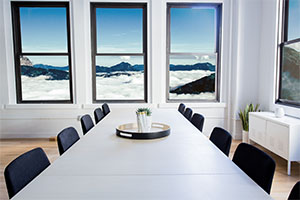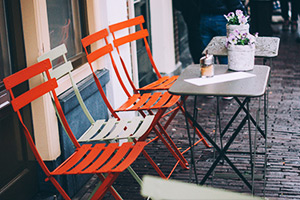


Introducing The Mirror World: The Next Revolution in Tech
10/04/2019
 Imagine sitting at your desk, looking out the window and seeing that you're above the clouds in the mountains. Imagine looking at a plant and being able to see information about it pop up as you focus on it. Imagine you decide to take the bus instead of the train and an arrow appears on the pavement showing you where the nearest bus stop is and how long it will take for you to walk there; as you walk, information about people you have met before is presented to you as you move towards them and places of interest are highlighted.
Imagine sitting at your desk, looking out the window and seeing that you're above the clouds in the mountains. Imagine looking at a plant and being able to see information about it pop up as you focus on it. Imagine you decide to take the bus instead of the train and an arrow appears on the pavement showing you where the nearest bus stop is and how long it will take for you to walk there; as you walk, information about people you have met before is presented to you as you move towards them and places of interest are highlighted.
This kind of virtual reality is heading our way. We will see an exact digital mirror-image of the world, viewed through a slimline pair of glasses or even contact lenses. It is thought to be similar to Street View in Google Maps, but instead of seeing a flat image, you will see depth. Everything will be 3D, the textures would be layered and complex and you would be able to interact with objects and manipulate them like we do in the real world.
 Similar technology is already appearing on our smartphones, with some furniture stores such as IKEA and Wayfair already offering an augmented reality (AR) app where you can place furniture in your room using the camera and can then walk around the space, looking through your phone to see how the object looks from all angles. An app by Google called Google Lens is also able to look at objects like plants to tell you what they are, or what breed a cat or dog is. It can also scan objects to see where you can buy them from or to find out more information about them.
Similar technology is already appearing on our smartphones, with some furniture stores such as IKEA and Wayfair already offering an augmented reality (AR) app where you can place furniture in your room using the camera and can then walk around the space, looking through your phone to see how the object looks from all angles. An app by Google called Google Lens is also able to look at objects like plants to tell you what they are, or what breed a cat or dog is. It can also scan objects to see where you can buy them from or to find out more information about them.
However, the Mirror World (as it has been currently conceived) would not overlay digital content onto the real world as AR does, but rather it would rely on advanced technology to continually scan the physical world from every angle using cameras, 24/7. As we move into the future, cameras are getting better but cheaper to make and will become smaller and smaller, enabling them to be placed anywhere and everywhere to keep up with our ever changing world. The data would also be captured from self-driving cars and from glasses or contact lenses with cameras in.
 It is hoped that eventually the AI looking at all this data will enable us to search through this digital mirror of our world, in the same way we search for things in a search engine. You might want to take a romantic stroll with your loved one for example, so you could therefore search for “riverside walks with a view of the sunset”, or you might want to have a coffee while sitting ouside a café down a quaint side street, and it would give you a list of options nearby. Physical objects would be linked together in the virtual world, creating a network of our surroundings like we’ve never seen before.
It is hoped that eventually the AI looking at all this data will enable us to search through this digital mirror of our world, in the same way we search for things in a search engine. You might want to take a romantic stroll with your loved one for example, so you could therefore search for “riverside walks with a view of the sunset”, or you might want to have a coffee while sitting ouside a café down a quaint side street, and it would give you a list of options nearby. Physical objects would be linked together in the virtual world, creating a network of our surroundings like we’ve never seen before.
Introducing this kind of tech could also bring virtual assistants like Siri and Alexa to life. Through our clever glasses or contacts, they could take a form, whether that’s as a human, animal, robot; maybe this would be something we could customise and choose ourselves! They would be able to read our facial expressions and sense our moods, or voice inflections, where we could receive an emotionally tailored response. We could also be shown objects in great detail and in 3D, as everything would be scanned and organised by AI. This would make an online shopping experience much more immersive since you could hold the virtual item in your hand and inspect it like you would in a real store.
There are so many applications for this upcoming and evolving technology which would open up a whole new world to everyone. This is already in development and some early models of this tech are already available to buy, so it this new virtual land will probably be available before too long!
